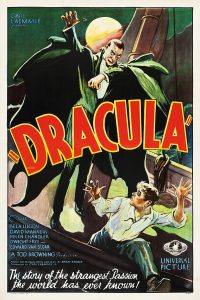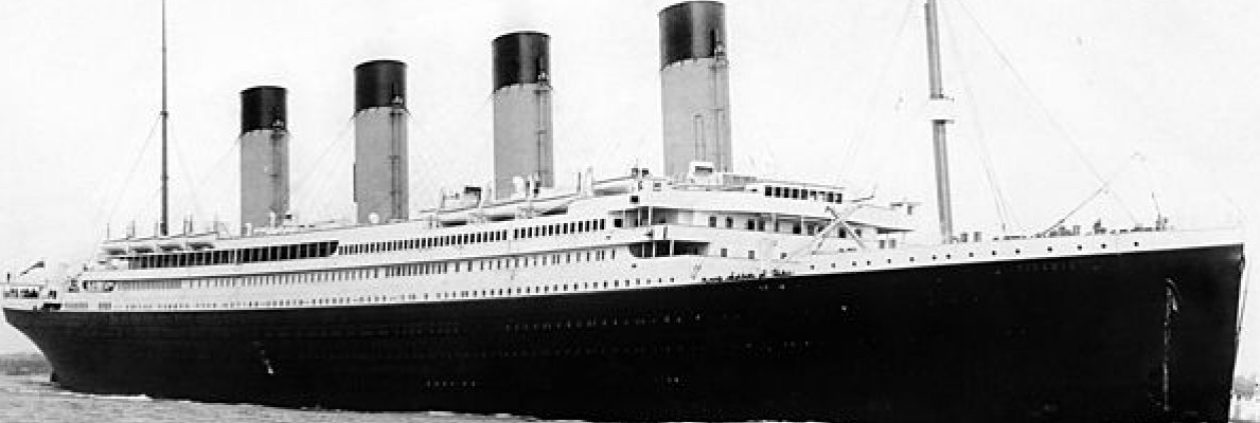
Public Domain via Wikimedia Commons
Todd Browning’s Dracula is considered a classic movie and is praised for its acting and the atmosphere it connotes. It was not the first movie adaptation of the Bram Stoker novel. Nosferatu was the first but since it was made without permission, was yanked from the theaters, and disappeared for a long time. That movie altered the story in keyways hoping to make it just different enough to pass muster. The 1931 movie borrowed from the stage version, a bit from the book, and a bit from the Nosferatu movie. While the story differs from the book, it makes up for it with great acting and made Bela Lugosi (who had played Dracula on stage) a household name.
For its time, Dracula was quite scary. Unlike today where blood and guts are shown in horror movies (and television or streaming ones as well), it was all about atmosphere to relay the horror of Dracula. The story opens with Renfield (not Jonathan Harker) on his way to meet with Count Dracula. He is warned by people to wait until the next day but says he must go. He is told about how they believe vampires live in that castle, which he scoffs at. He is given a crucifix to protect him. At Borgo Pass he is quickly tossed out with his baggage and the carriage speeds away. A carriage awaits him to take him to Castle Dracula. On the way he leans out and sees a large bat flying where the driver ought to be. When he gets to the castle, the door opens, and we see Dracula walking down the stairs to greet him. The entry is pretty much in ruin, unlike the book, and there is no greeting like the book where he is welcomed. An interesting spooky part is a large spider web that covers one part of the stairs. Dracula passes through it with no issue, but Renfield has to cut through it, and we see a large spider nearby. Dracula makes a comment about the spider living off blood and notes blood is life. The interesting scene (not the in book either) conveys that Dracula is a supernatural being.
After having his meal and showing Dracula the paperwork on Carfax Abbey, he retires to his room but not before cutting his finger and Dracula looking at him in a terrible way. In his room after opening the window, he falls to the ground. Dracula’s brides are there but are sent away by Dracula. The scene shifts to the Demeter where a crazed Renfield is serving his master and is found after the ship is boarded to find the crew dead. He is sent to a sanitarium run by Dr. Seward. We see Dracula attack a young girl before going to the theatre where he meets Dr. Seward, Jonathan Harker and his fiancée Mina Murray, and Lucy Westenra. That night he attacks Lucy while she is sleeping. We shift to what appears to be a medical examination of Lucy by Van Helsing noting that despite transfusions she dies. And the curious marks on her neck get his attention as well.
Meanwhile Renfield’s fascination with consuming flies and then spiders get Van Helsing’s attention. Renfeld wants to be sent away so his cries will not affect Mina. When Van Helsing shows him wolfsbane and how he fears it, he notes it is used to ward off vampires. Van Helsing in a meeting with Seward and others believes a vampire is at work. Meanwhile Dracula starts feeding on Mina causing her to relate strange dreams and her being fatigued. Dracula, who met them at the theatre, shows up. And it is here that Van Helsing’s suspicion that a vampire is about is confirmed. Dracula casts no reflection in the mirror of the cigarette box. Later when Van Helsing opens it in from of him, Dracula quickly tosses it away and for a moment we see his true face. After he regains control, he asks for pardon and departs. Renfield later relates he allowed Dracula to enter the sanitarium as he promised him lots of rats. Dracula returns later to confront Van Helsing by saying Mina is now his and for Van Helsing to return to his own country. Dracula tries to hypnotize him but fails. And Van Helsing uses a crucifix to force Dracula to retreat.
By now Mina knows about Dracula’ biting her and realizes her fate. She tells Jonathan that their love is finished. A vampire bat looms overhead, and she tries attacking Jonathan, but fails. Mina is being protected by wolfsbane around her neck and other protections, but Dracula uses hypnotism to get the maid to remove then and takes Mina. Van Helsing and Harker see Renfield escape and heading towards Carfax Abbey. Dracula believes he led them there and kills him. Van Helsing and Harker search the abbey and Harker finds Mina. Meanwhile Van Helsing finds Dracula in his coffin and kills him (offscreen). Mina then returns to normal, and the movie ends with Dracula dead and Mina free of his control.
The movie is now considered a classic and with good reason. While the story deviated substantially from the source material, it makes up for it with great acting and atmosphere that modern day horror movies fail to convey. And it became a template for vampire movies that would come after it (either made by Universal or by others later). Most vampire movies (with few exceptions) hue to the dusk to dawn nature of the vampire though, in the actual book, Dracula is free to move about during the day. However, the sun limits his abilities, and he has to stay in whatever form he is until sunset. Reviewers were shocked when Francis Ford Coppola had Dracula walking around by day in London in his movie. Had they read the book, they would not have been.
There were subsequent sequels to Dracula by Universal but none of them (except one- Abbott & Costello Meets Frankenstein 1948) had Bela Lugosi in them. After the movie, Lugosi sought to distance himself from the role believing he would be typecast. He did star in many movies with Boris Karloff but failed to grow beyond mad scientist type roles due his thick Hungarian accent. He was diagnosed with sciatic neuritis and became addicted to the prescribed drugs morphine and methadone. The drug dependence and his alcoholism contributed to him not getting major acting roles after 1948 relegating him to low-budget movies like Ed Wood’s Plan Nine from Outer Space (1957) which he died before it came out.
Bela Lugosi died of a heart attack on 16 August 1956 which occurred when he took a nap. His wife and daughter decided to bury him with his Dracula cape and cloak. Some later said he didn’t want that, but his son confirmed it was a decision that both he and his mother made consistent with his wishes. He was nearly broke at the time and his family could not afford his funeral. Frank Sinatra quietly paid the expenses for it. He is buried in the Holy Cross Cemetery in Culver City, California.
Sources
Ebert, Roger. “Dracula Movie Review &Amp; Film Summary (1931) | Roger Ebert.” Roger Ebert, 19 Sept. 1999, www.rogerebert.com/reviews/great-movie-dracula-1931.
Pfeiffer, Lee. “Dracula | Tod Browning’s Horror Film Classic, Bela Lugosi [1931].” Encyclopedia Britannica, 29 Sept. 2023, www.britannica.com/topic/Dracula-film.
Fear: The Home Of Horror. “Dracula (1931) Original Trailer | Classic Monsters.” YouTube, 31 Oct. 2020, www.youtube.com/watch?v=sSPNLK1wWaU.
,



















